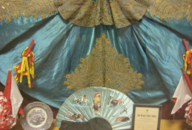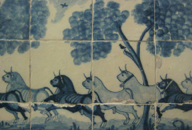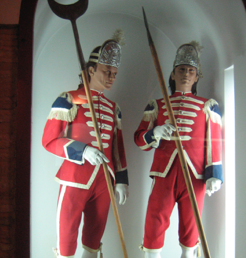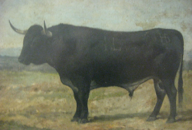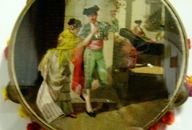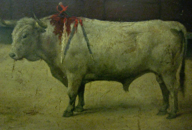museo taurino
real maestranza de caballeria
Seville, Andalusia, Spain


museo taurino
real maestranza de caballeria
Seville, Andalusia, Spain




Our tour of the Museo Taurino, located in the Plaza de Toros de la Maestranza de Caballeria, is a museum to the bull as well as the matador, and the history of bullfighting itself. Bullfighting began in the 18th century, derived after the art of jousting, a popular sport amongst knights, nobility and even royalty in Medieval Europe. When bullfighting first began, the costumes for the various players in the bull ring were derived from 18th century European aristocratic fashion, with men wearing longer, shaped jackets, britches and stockings with flat shoes. In the beginning, matadors wore these same styled longer jackets, only to find that the bull could reach beneath it with his horns, allowing the matador to be too vulnerable. The matador’s costume was soon restyled with tighter clothing and short jackets, fitted close to the body, with encrustations of embroidery and beading to provide some protection against the sharp horns of the bull. The style has never changed since this modification. We saw vitrines exhibiting matadors’ costumes, one small enough to fit an 8-year old boy, the age at which one of the longest lived and most famous matadors first entered the ring. He died of natural causes at the age of 85, sitting at a barstool in his favorite bar. Another matador’s costume exhibited here weighed 18 kilograms (almost 40 pounds), a significant weight and armor. A beautifully embroidered muleta (cape) in blue satin filled one case, proof that these are not always red. Henry and I learned that the bulls only see in shades of black, white and gray, and are otherwise blind to colors. Therefore, it is not the red cape that aggravates the bull, but rather the movement of the cape, and the banderillas (darts) in his back that provoke his anger. Heads of bulls were mounted on high walls around the museum, each with a name and history. Posters and paintings of the bulls and the matadors were also framed and installed in strategic places. We saw bronze sculptures of famous bulls, and heard the sad history of a bullfighter’s death. Recently, one of Seville’s most popular matadors (name unknown to me) was gored in two separate incidents. The first missed his jugular vein by only an inch, sparing his life. The second, found him gored in three places on one side of his body. We were told that matadors prefer to be gored in the heart rather than the stomach, as death is swifter and less painful. Because the public has the scent of blood with this current-day matador, he is commanding exorbitant amounts of money for his next . and perhaps final appearance in the bullring. I wish him luck!
PHOTOS: Left Column: 1. Royal crest embroidered on velvet, a decoration for the bandstand in the early days of bullfighting. 2. Painting of an incident in the bullring. Note that the bull has entered the stalls. 3. Painting, famous toro bravo. 4. Painting on a tambourine. Subject: matador leaving his sweetheart before entering the bullring. Center, Top: Paintings of famous bullfighters from Seville, and the head of a famous bull. Center, Bottom: Two matador’s “assistants” from the 18th century. The current costume came directly from this attire, only the jacket and hat have been changed. Right Column: 1. Vitrine displaying an embroidered muleta in blue satin. 2. A series of tiles showing bulls being happily paraded to the bullring. 3. Painting, another famous toro bravo. 4. Painting of a bullfight.

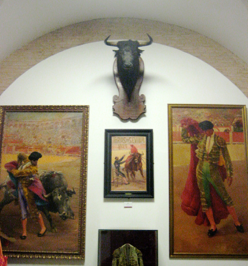
All About the Bullfight
